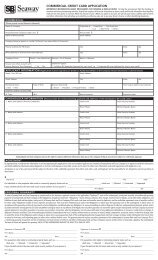Same commitment. - Seaway Bank and Trust Company
Same commitment. - Seaway Bank and Trust Company
Same commitment. - Seaway Bank and Trust Company
Create successful ePaper yourself
Turn your PDF publications into a flip-book with our unique Google optimized e-Paper software.
Notes to Financial Statements<br />
For the Years Ended December 31, 2008 <strong>and</strong> 2007<br />
Note 1 — Summary of Significant Accounting <strong>and</strong> Reporting Policies<br />
The financial reporting <strong>and</strong> accounting policies of <strong>Seaway</strong> Bancshares, Inc. (the<br />
“Corporation”) <strong>and</strong> its subsidiary, <strong>Seaway</strong> <strong>Bank</strong> <strong>and</strong> <strong>Trust</strong> <strong>Company</strong> (the “<strong>Bank</strong>”),<br />
conform to accounting principles generally accepted in the United States <strong>and</strong> to<br />
general practices within the banking industry. The following is a summary of the<br />
significant accounting policies.<br />
NATURE OF OPERATIONS<br />
<strong>Seaway</strong> Bancshares, Inc. is a bank holding company whose principal activity is<br />
the ownership <strong>and</strong> management of its wholly-owned subsidiary <strong>Seaway</strong> <strong>Bank</strong><br />
<strong>and</strong> <strong>Trust</strong> <strong>Company</strong>. The <strong>Bank</strong> generates commercial, mortgage <strong>and</strong> consumer<br />
loans <strong>and</strong> receives deposits from customers located primarily in Chicago, Illinois<br />
<strong>and</strong> the surrounding area. On December 30, 2007, the Illinois Department of<br />
Financial <strong>and</strong> Professional Regulation (IDFPR) approved the conversion of<br />
<strong>Seaway</strong> National <strong>Bank</strong> of Chicago to a bank chartered by the State of Illinois.<br />
IDFPR issued a charter to the converting bank under the name of <strong>Seaway</strong> <strong>Bank</strong><br />
<strong>and</strong> <strong>Trust</strong> <strong>Company</strong>. The <strong>Bank</strong> is subject to regulation by the Federal Deposit<br />
Insurance Corporation.<br />
PRINCIPLES OF CONSOLIDATION<br />
The accompanying consolidated financial statements include the accounts of the<br />
Corporation <strong>and</strong> the <strong>Bank</strong>. All intercompany accounts <strong>and</strong> transactions have been<br />
eliminated in the consolidated financial statements.<br />
In accordance with Financial Accounting St<strong>and</strong>ards Board Interpretation<br />
No. 46, (R),“Consolidation of Variable Interest Entities” [“FIN 46 (R)”], the<br />
accompanying consolidated financial statements do not include the accounts of<br />
a wholly-owned financed subsidiary (the “<strong>Trust</strong>”). The <strong>Trust</strong> was formed for the<br />
sole purpose of issuing <strong>Trust</strong> Preferred securities <strong>and</strong>, in turn, purchasing subordinated<br />
debentures from the Corporation.<br />
Under the provisions of FIN 46 (R), the <strong>Trust</strong> is considered a “Variable Interest<br />
Entity” (“VIE”), which can only be consolidated if the Corporation is subject<br />
to a majority of the risk of loss from the VIE activity or is entitled to receive a<br />
majority of the entity’s residual returns. The design of the <strong>Trust</strong>, which is very<br />
common in the banking industry, is such that the Corporation is neither subject<br />
to the majority of risk of loss nor entitled to receive the majority of any residual<br />
returns. As a result, the <strong>Trust</strong> is not consolidated.<br />
The Corporation does, however, report the subordinated debentures sold to<br />
the <strong>Trust</strong> as a liability in the Consolidated Balance Sheets <strong>and</strong> associated interest<br />
expense in the Consolidated Statements of Income.<br />
USE OF ESTIMATES<br />
The preparation of financial statements in conformity with generally accepted<br />
accounting principles in the United States of America requires management to<br />
make estimates <strong>and</strong> assumptions that affect the reported amounts of assets <strong>and</strong><br />
liabilities <strong>and</strong> disclosure of contingent assets <strong>and</strong> liabilities at the date of the financial<br />
statements <strong>and</strong> the reported amounts of revenue <strong>and</strong> expenses during the<br />
reporting period. Actual results could differ from those estimates.<br />
Classification Accounting Treatment<br />
Held-to-Maturity Carried at Amortized Cost<br />
Trading Securities Carried at fair value with unrealized holding<br />
gains <strong>and</strong> losses included in earnings<br />
Available-For-Sale Carried at fair value with unrealized holding gains<br />
<strong>and</strong> losses excluded from earnings, <strong>and</strong> reported as a<br />
separate component of Shareholders’ equity, net of tax,<br />
as accumulated other comprehensive income<br />
The decision to purchase securities is based on a current assessment of expected<br />
economic conditions including the interest rate environment. The determination<br />
to sell such securities is based on management’s assessment of changes in<br />
economic or financial market conditions, interest rate risk <strong>and</strong> balance sheet <strong>and</strong><br />
liquidity positions. The adjusted cost of the specific security sold is the basis for<br />
determining gains <strong>and</strong> losses.<br />
LOANS<br />
The Corporation’s loan portfolio includes residential <strong>and</strong> commercial mortgages<br />
<strong>and</strong> commercial <strong>and</strong> consumer loan products. Loans are stated at unpaid<br />
principal balances less the allowance for loan losses <strong>and</strong> net deferred loan fees <strong>and</strong><br />
unearned discounts. Unearned discount is recognized as income over the terms<br />
of the loan by the sum-of-the-months digit method, the result of which is not<br />
materially different from that obtained by using the interest method. Interest on<br />
other loans is reported on the accrual basis throughout the terms of the loans.<br />
Loans are placed on a non-accrual (cash) basis for recognition of interest<br />
income when interest earned in excess of ninety days is delinquent or principal<br />
is delinquent in excess of ninety days <strong>and</strong> the loan is either not well collateralized<br />
or is in the process of collection. The non-recognition of interest does not<br />
constitute forgiveness of the interest.<br />
ALLOWANCE FOR LOAN LOSSES<br />
The allowance for loan losses is maintained at a level that, in management’s judgment,<br />
is adequate to provide for estimated probable losses from loans. The amount<br />
of the allowance is based on management’s formal review <strong>and</strong> analysis of potential<br />
losses, as well as prevailing economic conditions. The allowance is increased by<br />
provisions for losses, which are charged to earnings <strong>and</strong> reduced by charge-offs,<br />
net of recoveries.<br />
The allowance consists of specific, general, <strong>and</strong> unallocated components. The<br />
specific component relates to loans that are classified as doubtful, subst<strong>and</strong>ard, or<br />
special mention. For such loans that are also classified as impaired, an allowance<br />
is established when the discounted cash flows (or collateral value or observable<br />
market price) of the impaired loan is lower than the carrying value of that loan.<br />
The general component covers non-classified loans <strong>and</strong> is based on historical loss<br />
experience adjusted for qualitative factors. An unallocated component is maintained<br />
to cover uncertainties that could affect management’s estimate of probable<br />
losses.<br />
While management uses available information to recognize losses on loans,<br />
further reduction in the carrying amounts of loans maybe necessary based on<br />
changes in local economic conditions. It is reasonably possible that the estimated<br />
losses on loans may change materially in the near term. However, the amount of<br />
the change that is reasonably possible cannot be estimated.<br />
IMPAIRMENT OF LOANS<br />
Loans are considered impaired when it is probable that the total amount due,<br />
including accrued interest, will not be collected according to the contracted<br />
terms <strong>and</strong> schedules of the Loan Agreement. Income related to impaired loans is<br />
recognized when earned, unless the loan has also been placed on a non-accrual<br />
(cash) basis, for the recognition of interest income.<br />
FEES RELATED TO LENDING ACTIVITIES<br />
Loan origination fees <strong>and</strong> direct loan origination costs that are incurred on a<br />
specific loan are offset against each other <strong>and</strong> the net amount is deferred <strong>and</strong><br />
recognized over the life of the loan as an adjustment of the loans’ yield. Commitment<br />
fees <strong>and</strong> direct loan origination costs that are incurred to make a <strong>commitment</strong><br />
to originate a specific loan shall be offset against each other <strong>and</strong> only the<br />
net amount is deferred <strong>and</strong> recognized over the life of the loan as an adjustment<br />
of the loans’ yield.<br />
PREMISES AND EQUIPMENT<br />
Premises <strong>and</strong> equipment are stated at cost less accumulated depreciation. Depreciation<br />
is computed on the straight-line method over the estimated useful lives of<br />
the related assets, ranging from 3 to 40 years.<br />
INCOME TAXES<br />
Prior to 2001 the Corporation filed a consolidated Federal Income Tax return.<br />
Amounts provided for income taxes were based on income reported for financial<br />
statement purposes. Provisions for deferred income taxes were made as a result of<br />
timing differences between the period in which certain income <strong>and</strong> expenses are<br />
recognized for financial reporting purposes <strong>and</strong> the period in which they affect<br />
taxable income. The principal items causing these timing differences were the<br />
provision for possible loan losses <strong>and</strong> depreciation. Effective January I, 2001, the<br />
Corporation <strong>and</strong> the <strong>Bank</strong> jointly elected to be treated as an S Corporation for<br />
federal income tax purposes. As an S Corporation, both the Corporation <strong>and</strong> the<br />
<strong>Bank</strong> are liable for federal corporate level income taxes on certain “built-in gains”<br />
existing at December 31, 2000, which are recognized after that date <strong>and</strong> any<br />
applicable state corporate level income taxes, (including the Illinois Replacement<br />
Tax). As a further consequence of the S Corporation election, both the Corporation<br />
<strong>and</strong> the <strong>Bank</strong> were required to revalue deferred tax assets <strong>and</strong> liabilities at the<br />
lower statutory tax rates applicable to S Corporations.<br />
In June 2006, the Financial Accounting St<strong>and</strong>ards Board (“FASB”) issued<br />
FASB Interpretation No. 48 (“FIN 48”), “Accounting for Uncertainty in<br />
Income Taxes-an interpretation of FASB Statement No. 109” (“FIN 48”). FIN<br />
48 prescribes a recognition threshold <strong>and</strong> measurement process for recording in<br />
the financial statements uncertain tax positions taken or expected to be taken in a<br />
tax return in accordance with SFAS No. 109 “Accounting for Income Taxes.” Tax<br />
positions must meet a more-likely-than-not recognition threshold at the effective<br />
date to be recognized upon the adoption of FIN 48 <strong>and</strong> in subsequent periods.<br />
The accounting provision of FIN 48 was effective for the Corporation beginning<br />
January 1, 2007. The impact of adoption on the <strong>Bank</strong>’s financial position <strong>and</strong><br />
15







